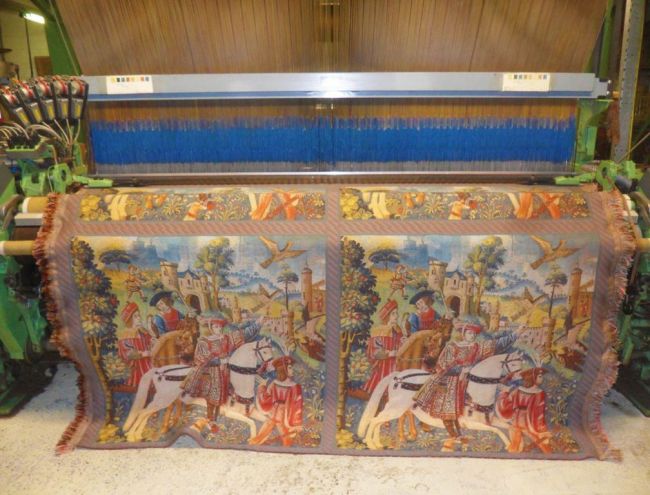Flanders Art
Single warp control has been pos-sible since Jacquard invented his loom in 1804 – the result of a long series of improvements on the ancient drawloom, which enabled pictorial repeats in weavings as early as the pre-Christian era. It took all but another 200 years for single warp control via punched cards to be replaced by electronic means, resulting in products now suitable as a woven base for the art market (the first electronic jacquard machine was presented by the Belgian company Bonas at the Milan ITMA fair for textile machinery in 1983). Even in the early days of jacquard machines, which wove fine damasks and fabrics for interior textiles and made them affordable for the wider population, so-called jacquard tapestries were also machine-produced in wool; according to a German law passed in 1913,
they needed to be described as "imitation gobelins" to distinguish them from
woven tapestries.
Flanders and France were the strongholds of tapestry for many centuries. Later those countries also wove the more affordable "machine-made gobelins". It is thus not surprising that woven pictures for contemporary artists are "printed" by the Flanders Tapestries company located in Wielsbeke near Kortrijk, the home of the first electronically controlled jacquard machine. The company was surprised to hear that we thought them to be the only manufacturer in the world specialising in Jacquard "tapestries". And sure enough, when perusing the catalogue of the Frankfurt Heimtextil fair I iden-
tified some 13 companies who claimed
to make jacquard "tapestries", including two in Belgium, two in France,
two in the UK, three in the USA, two in Canada and one in China. After some cursory research on the internet, we found that twelve of the companies have released "tapestry" collections
in the style of older jacquard machines which they offer to the trade – one
of them Flanders Tapestries, although their range targets the specialised
art trade.
The special service performed by Flanders Tapestries is close co-operation with the artists. Usually industrial manufacturers shy away from one-off commissions as these require time-consuming co-ordination with non-specialists. Similar to other jacquard companies, Flanders Tapestries maintains an additional "tapestry" collection marketed under the "Ryato – Art
Made Tapestries" label, presented at the
January 2007 Heimtextil fair where
we first encountered the company.
At that time it already worked in close co-operation with Magnolia, a Californian art print studio whose field of activity prompted a horrified comment from us in TF 4/2004 (page 2), the year we learnt about its working method – unaware of the fact that it had expanded its "printing" concept to include reputable jacquard "tapestries" produced by Flanders Tapestries.
THE CONTROVERSY
In our capacity as magazine publishers in the field of textile art, crafts and industrial design, with an eye to the relevant education and cultural heritage, we used to consistently ignore so-called painter tapestries, i.e. art pieces subsequently converted into textile images by means of the tapestry or jacquard technique. In our perception, painter tapestries do not constitute textile art, even though they may consist of textile materials and use textile techniques.
In our opinion, failure to draw this distinction postulates an essential difference between the artist as the author and the craftsperson as a servant to the artist. We believe that Walter Gropius’ statement in the 1919 Bauhaus manifesto still holds true: "Architects, sculptors, painters, we must all return to the crafts! For art is not a ‘profession’. There is no essential difference between the artist and the craftsman."
Time and again in recent years, textile artists have introduced us to artists whose attribution to textile art would appear doubtful to us, such as Grayson Perry, the eccentric ceramicist and winner of the British Turner Prize (see
TF 2/2010, p. 10) who may make his debut at the first Chinese "Fiber Visions" Triennial in September of this year.
For its "Rewind History" programme section, the 8th Kaunas Biennial, 'Textile 11' held in 2011, asked weaving lecturer Monika Zaltauskaitè-Grašiene to produce jacquard reproductions of paintings by well-known 20th and 21st century Lithuanian fine artists for display in a travelling exhibition abroad. Apparently the usual photo documentary of the pieces did not suffice for the organisers, or they may have wished to divert funds provided for a show of textile art and to use them in an advertising campaign promoting Lithuanian artists... Having said that, the composition of the weavings was highly sensitive and each image individually designed in terms of materials and technique, so we were prepared to concede a certain authorship as textile art to such interpretations of original works.
Again and again, so-called painter tapestries raise the question of authorship! In the case of the objects produced by Flanders Tapestries, the jacquard weaver and company owner Christian Dekeukelaere exercised complete self-restraint, perceiving himself as (just) a craftsman, albeit a highly
inventive one. He said that as an artist, he would be obliged to visit galleries, and that was not for him.
continued on page 22
DIGITAL "TAPESTRIES"
Beatrijs Sterk
Wallhanging "Chasse", 96 x 106 cm, on the loom at Flanders Tapestries.
This "tapestry" is offered in two sizes and part of the mill's standard repertoire.
Photo in March 2013, B. Sterk
Read more: order magazine june 2013 "http://www.tfs-etn.com/index.htm"
|


